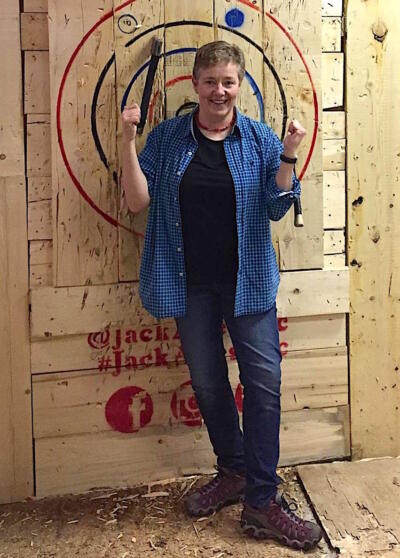1720 Eleven galvanized narratives
The Love Olympics
by Claire Wilkshire
St. John’s, Newfoundland: Breakwater Books, 2021
$21.95 / 9781550819083
Reviewed by Peter Babiak
*
 I re-read this collection of short stories during that tranquil week between Christmas and New Years and came to a slightly different conclusion than I did after the first read. When I first read The Love Olympics I was drawn to Claire Wilkshire’s intelligent stories. They’re entertaining, compelling, and engaging, everything a reader wants in a short story. She’s an excellent writer, plain and simple: the excellence comes down to her characterizations, which she executes through metaphorically-innovative descriptions and impeccably structured dialogue, and through her commanding narrative points of view which are so inconspicuous that they almost seem to recede into her graceful language. As with all good literary fiction, her characters remind us to think carefully—longer, more patiently, perhaps with a degree of empathy or understanding we don’t always enlist—about the characters who inhabit our everyday lives, to their actions and interactions with one another, to what they say in dialogue but also to what they might leave out. These characters are not atomized individuals; rather, the characters in Wilkshire’s eleven stories form, slowly and by degrees, a sort of organic whole or a community of characters. And the unifying theme that binds them is love, in all of its different manifestations—parental, maternal, romantic, platonic, imagined, and so on—and this theme sutures each story to all the others in the enchanting setting of St. John’s, Newfoundland, a near-mythical place in the popular Canadian imagination.
I re-read this collection of short stories during that tranquil week between Christmas and New Years and came to a slightly different conclusion than I did after the first read. When I first read The Love Olympics I was drawn to Claire Wilkshire’s intelligent stories. They’re entertaining, compelling, and engaging, everything a reader wants in a short story. She’s an excellent writer, plain and simple: the excellence comes down to her characterizations, which she executes through metaphorically-innovative descriptions and impeccably structured dialogue, and through her commanding narrative points of view which are so inconspicuous that they almost seem to recede into her graceful language. As with all good literary fiction, her characters remind us to think carefully—longer, more patiently, perhaps with a degree of empathy or understanding we don’t always enlist—about the characters who inhabit our everyday lives, to their actions and interactions with one another, to what they say in dialogue but also to what they might leave out. These characters are not atomized individuals; rather, the characters in Wilkshire’s eleven stories form, slowly and by degrees, a sort of organic whole or a community of characters. And the unifying theme that binds them is love, in all of its different manifestations—parental, maternal, romantic, platonic, imagined, and so on—and this theme sutures each story to all the others in the enchanting setting of St. John’s, Newfoundland, a near-mythical place in the popular Canadian imagination.

The second time I read The Love Olympics I came to another conclusion. This is the kind of book I want to tell other people about. Tell them, specifically, about Wilkshire’s unwavering language-attentiveness—some would call this artistry, but that’s too indistinct a term for her sharp, philologically-inspired writing—that galvanizes the eleven narratives, about her elegant command of sentence style that, quit often but not too often, will arrest their reading and lead them to wonder how a phrase or a combination of clauses can unsettle thoughts and ideas, shift and transform them into other, better or just different, thoughts and ideas. These eleven stories are all engaging enough in terms of their content, a distinct pleasure to read, but at their core they’re joyful language experiences that underscore the pure writtenness of this community of characters. I didn’t come to this conclusion because I’d been lulled by the holiday spirit—though this possibility did, in fact, occur to me given that the stories in The Love Olympics orbit around the joy and hope signified by that weighty adjective in the title. The simple reason is that, during that week after Christmas I had time to slow down my reading and attend to Wilkshire’s form and technique, to how she scaffolds characters, erects their psychologies, their actions and interactions. It’s not magic; it’s diction and clauses, sentences and paragraphs, or the textuality at the core of all good literary fiction, though that textuality is too often sidelined in favour of simpler nonlinguistic matters.
Goodreads is a decent, if at times hyperbolic and capricious, barometer of the public perception of a book, I know, but here’s a comment I came across from another reader of Love Olympics: “I loved noticing how the characters showed up in each other’s stories”. As unremarkable as this seems, it touches on one of the most notable elements in Wilkshire’s collection: these stories overlap and intersect—a tertiary character referenced in one. For example, a tertiary character in “The Dinner”, Anthony, whom protagonist Cath refers to only as “the Nice Young Man” who cleans her Nan’s walkway in “Dinner”, is only named near the end of that story, yet he was also the amiable but unnamed protagonist in an earlier story in the narrative, “Snow”. In this story, which is one of my favourites simply because it adheres to a more-or-less classic romantic structure, Anthony reacquaints himself, first platonically but then sexually, too, with Jessica, a woman who’s returned to St John’s after some years in Toronto. Jessica, in turn, also appears briefly as something of a foil to Cath’s undeclared romantic fantasy in “The Dinner”, the longest and most substantive story in the collection. For her part, Nan, the first person narrator in “Fourteen Steps”, the most innovative of the stories because it concerns a 91 year old who is “getting frailer and sometimes unreasonable” and so takes a regimented, numerical structure, has already been established as a constituent subject in “The Dinner” and elsewhere—“she had been pouring her love unstoppably into Cathy for fifty years”, which is such a perfect metaphor—as a kind of elderly quilting point in this community of characters.
Now, this isn’t the baroque architecture of a William Faulkner story where you need to diagram the connections between characters to understand the plots. These stories aren’t exceedingly intricate because the connections aren’t the least bit forced; on the contrary, Wilkshire’s binding agents are so ordinarily rendered and realistically unremarkable that they seem arbitrary or even banal. The characters connect simply because they live in a community. In this sense, Love Olympics reminds me of Alice Munro’s Lives of Girls and Women, though Munro’s collection is concerned only with one, Del Jordan, whereas something far more social or dialogic is at work in Wilkshire, whose characters become vivid not just for who they are but rather for how they fit into their larger St. John’s setting. The similarity with Munro is more apparent in their narrative structure. As Ginny Ratsoy noted some months ago on these pages, “Munro writes story cycles—linked short stories that can be read wholly individually, but gain added resonance when read together”, and I’d say the same can be said about Wilkshire’s book. They are story cycles focussed on the shared settlement of a ity, or perhaps on the character of the community itself.
Stories, the stuff we say to people or what we think but don’t say out loud, are the bricks and mortar that govern how all of us, in both literature and life, are built, and Wilkshire’s characterisations are exceptionally well executed. Usually, these characterisations are presented in her narrator’s observations. For instance, the narrator in “Snow”, in relating how Jessica responds to Anthony’s jokes prior to the more intimate stage of their relationship, tells us “she slapped her hand a few times on the table or her thigh”, which isn’t the least bit remarkable, but that’s only the core of the sentence. There’s an em-dash followed by these metaphorically nimble and cumulatively revealing clauses that reorient that first clause: “it was a kind of applause, a way she had of giving herself over physically to humour, as if she were being swept away by an avalanche of pleasure. Or jumping into the path of one.” The robust events that will soon bind their fates are implied in this virtuoso sentence that encodes Jessica’s two different responses to this metaphorical avalanche of his humour, though really it has more to do with the encroaching intimacy between them. I suppose another way of saying this is that Wilkshire really knows how to write the tension that defines romance. Anthony eventually kisses Jessica—“The inside of her mouth felt friendly he thinks”, which is such an awesome metaphor—and then the narrator offers this immanently logical-chopping sentence that portends the next step in their romantic narrative: “What happened next, if it did happen, would change everything, and if it didn’t, that would change everything as well”.

It’s rare to read a single sentence whose syntax, marked by parallel embedded clauses that pull in two different directions at once, so aptly demonstrates at the basic linguistic level the difficulty of metaphorically reading intimate moments with potential lovers in real life. That kiss changed everything, as kissing tends to do, but we’re left hanging because, though we’re pretty sure about what is going to happen next, Anthony isn’t. This one sentence renders the narrator an exacting presence, but not one without a sense of humour. Later, at the potential tipping-point in the story, after Anthony sees Jessica with the man she told him was her husband, he finds himself up at night wondering about semantics that lay behind the consummation of their intimacy. He analyzed—or maybe he obsessed over—the language she used when she told him about Chris: “Surely if someone says I’m done with insert-husband’s-name-here, you are not morally obliged to produce a three-page questionnaire, to demand a precise definition of done or to verify that insert-husband’s-name-here’s understanding of the situation corresponds fairly closely to that of your interlocutor.” Anthony’s description, with its intentionally absurd precision, will be familiar to anybody who’s gone over a potential lover’s words with the degree of scrutiny typically reserved for the analysis of poetry. We’re not only told what Anthony feels in that moment but are shown the layout of his mind in the very grammar of that sentence itself. This technicality, which is probably the defining characteristic of literature, reveals so much about him; we should also keep in mind that Anthony is only ever referred to as “he” in “Snow”, which makes his characterisation so much more intense given that we tend to empathize and even just understand characters more, perhaps better, when they have proper names and aren’t just identified with clinical pronouns. Characterisation is at its best when the writer knows that the “characters” in stories we read share an etymology with those other “characters”, the letters that constitute written languages.
Stories, the American writer Andre Dubus says, “are the way we live”. Each of the eleven stories in Love Olympics reveal glimpses of lives lived. It’s not just the lives, though, but “the way”, or how these lives are lived, which is a question that has much more to do with considerations of language than basic, unspoken actions. Take, for instance, “The Dinner”, which concerns three middle aged women—Cathy, Pam, and Angela—who the narrator indicates “were a hundred and fifty now, collectively”. The three get together or “converge” at Cathy’s to mark Pam’s birthday, since she “was the last of them to hit the half-century point”. From the get-go, Wilkshire’s attention here is again trained on the particles of writing, particles that have a lot more to do with establishing characters and the psychological setting of their plot. I was particularly struck at the fresh metaphors, as when we read that from her kitchen window Cathy watched “the passenger door yawn open” to reveal Pam, that when she opened that window it made “a sound like a low, smacking kiss”, and that she felt “the lick of cool air” as the window opened. One of the first things we learn about Cathy, which comes in the form of a statement when the three women have taken their seats in her living room, is this: “Whatever happens, Cathy thought, I’m not going to tell them about Morgan. There’s no need.” Which means, of course, that she will likely tell them about Morgan, her “holier-than-thou vegan daughter who wasn’t quite so holier-than-thou since Cathy had seen her smoking downtown outside the restaurant where she waited tables”. Which means, naturally, that she does.
Characterisation, which is likely the only reason some stories are better than others, is animated by Wilkshire’s lovely metaphors and figural turns of phrase. We are not just told that Pam is officious and professional, which she is, but that she is “a kind of government giant squid, a highly intelligent cephalopod operating well below the surface.” Angela had “always been beautiful” but, the narrator adds, slightly given to melodrama, though she “wasn’t going to hijack the evening with tales of woe” and, besides, “[e]verything was not okay on the home front, but it was better than it had been”. As for Cathy, the hostess, we already know about her but here, in a single periodic sentence, Wilkshire again demonstrates her skill at forming impeccable sentences that erect and sustain her characters. “’Now just to be clear’,” Cathy tells her two friends in an attempt to guide the conversation, “‘we are NOT—’she was trying to spear a slim rectangle of red pepper on her fork, but the red pepper had been roasted and then rinsed in lemon mustard dressing, and Cathy’s fork chased it around the plate, plunging occasionally, the red pepper always one slippery sideways wriggle away, but now, after a period of deceptive stillness, the tines bore down suddenly, a triple piercing, and Cathy brandished it like a little red flag as she spoke – ‘NOT going to sit here and talk about MENO-pause.” The humour is clear, but such protracted phrasing with its suspended syntax which really is like the linguistic equivalent of a memorable mise-en-scène in film also demonstrates that character is fundamentally about language, and that the nature of friendships is gauged in terms of the words people share, or that suture the connections between them. Some linguists maintain that language is an abstracted form of primal grooming: where our ancestors, and animals, established relations of familial kinship or clan affiliation by physical touch, we use words to connect with friends. It’s really the words that constitute those friendships and that’s what transpires so intensely in “The Dinner”.
The three women start “with the catching-up talk, the latest news, the family updates, the miscellaneous gossip … before they could get into the serious business of the evening, the stories, the cackles and guffaws, the revelations, the remembering, the gradual laying bare of the soul.” The narrator clarifies their loquaciousness by explaining that they could “cover a table with their problems as if they were in a tapas bar”, but then adds, strikingly and with an eye trained on the simple beauty of having friends, that “they would each leave feeling that the hopeless thing was not hopeless after all.” Because these three friends “dealt in hope”, as all friends should do for us and we for them, and hope is something—like love—that we convey, or perhaps I should say produce, in our words not in our actions.

Of all the notable features in Wilkshire’s story telling—the novel metaphors, the apt characterisations, the tempo in her narratives, the conflicts the generate the literary tension, the understated connections between character—the most dazzling is, for me, her sentences and grammatical constructions. It wasn’t until the second time I read her that I noticed that she often, and impressively, pivots from the terse prose that drives her plots along at an entertaining pace to a longer-than-usual sentence. Though Hemingway was probably right to say that it was about time that the long sentences of 18th and 19th century literature were tossed aside in favour of more modern, journalistic sentences, the simple fact of the matter is that not everything we want to communicate can be communicated in the space of a simple sentence, least of all the sometimes confounding mental topography we’re in when we experience love, whatever it is. A longer-than-usual, hypotactic syntax, with its ability to take in paradoxes and ironies, render organization and hierarchy in thought, is what you need when you want to scaffold those sort of experiences in words.
In “Baby Whales”, for example, where Becca, who is Angela’s daughter, considers her mother’s bothersome questioning about the girl’s schedule, or in “The Lesson”, where Angela, who’s been wondering why it’s so hard dealing with “adult children”, imagines a cave in Scotland, a place she’s never been, because it seems like the ideal location for an escape from everybody. At the end of “Work-in-Progress”, where Cathy’s daughter Morgan wonders and worries whether she’ll be loved by anybody other than her parents, and in “The Love Olympics”, where the omniscient narrator addresses the unnamed “you”—the subject of this interesting second-person story—as an infant wearing “the barnyard jammies” their mother had made. The most riveting, and longest, is the 253- word labour of syntactic finery in “The Dinner”, which could probably pass as an exemplary work of flash fiction on its own. In it, the narrator explains that the three friends “had started saying I love you to each other in the last year, at the end of walk or a phone call”, moves through a narrative expose of why they—and we—don’t say it much, then concludes, at once brilliantly but more so beautifully, with a simple nod to “loving generously and widely and well”. If a single sentence can lead readers to feel shivers run down their spines—and all readers know it can—this is one of them.
I think of meticulous sentence craft like this as cinematic frames at climactic moments in a film. Having arrested the narrative for a moment, the composition of the sentence takes us back to the reason we read short stories in the first place. To be entertained, yes, but to understand a thing or two about the tough language work that creates this entertainment. These long, thought-filled sentences work, too, because these stories, though varied and distinct, never move too far from that theme or practice or language of love. We connect to short stories because of character and plot, but we can only temporarily pretend that the language that delivers them—the words, phrases, clauses—doesn’t really exist and that we are actually there “in” the story. In his terrific book, The Canadian Short Story, John Metcalf, an under-appreciated critic who’s never been too timid to say that good literature requires a lot of expertise, skill and talent, considers a single sentence he once read in Cyril Connolly. This one sentence, he says, “forced me to think about verbs and nouns, adjectives and adverbs, the nature and level of diction, the placement of words within sentences, the rhythms of sentences, the functions of punctuation. In brief, it forced me to consider writing as technical performance, as rhetoric organized to achieve planned emotional effects.” As unsexy as this nod to the linguistics of literariness might sound, it should be music to the ears of any reader who esteems good writing.
Wilkshire is a gifted writer. It’s clear that she enjoys writing but her enjoyment never collapses into gimmickry or cleverness. The Love Olympics is a happy collection. “A writer is not someone who expresses his thoughts, his passions, or his imagination in sentences,” Roland Barthes said in The Pleasure of the Text, “but someone who thinks sentences: A sentences-Thinker”. And Wilkshire is, in this collection of stories you really should read, a sentence-thinker.
*

Born and raised in the GTA, Peter Babiak now lives and writes in East Vancouver. He teaches linguistics, composition, and English Lit at Langara College, and writes for subTerrain magazine. His commentary and creative nonfiction has been nominated for both BC and national magazine awards and his collection of essays — Garage Criticism: Cultural Missives in an Age of Distraction, published by Anvil Press in 2016 — was a Montaigne Medal finalist and an Honourable Mention in the Culture Category of the Eric Hoffer Awards. His work was selected for The Best Canadian Essays (Tightrope Books) both in 2017 and 2018. He has a dog, a cat, a garden, and an alluring garage. Editor’s note: Peter Babiak has recently reviewed books by Heather Haley, Trevor Newland, Douglas Coupland, Clint Burnham, Stan Rogal, and Jamie Lamb, and his book Garage Criticism was reviewed by Ginny Ratsoy, for The British Columbia Review.
*
The British Columbia Review
Publisher and Editor: Richard Mackie
Formerly The Ormsby Review, The British Columbia Review is an on-line book review and journal service for BC writers and readers. The Advisory Board consists of Jean Barman, Wade Davis, Robin Fisher, Barry Gough, Hugh Johnston, Kathy Mezei, Patricia Roy, Maria Tippett, and Graeme Wynn. Provincial Government Patron (since September 2018): Creative BC. Honorary Patron: Yosef Wosk. Scholarly Patron: SFU Graduate Liberal Studies.
“Only connect.” – E.M. Forster
One comment on “1720 Eleven galvanized narratives”